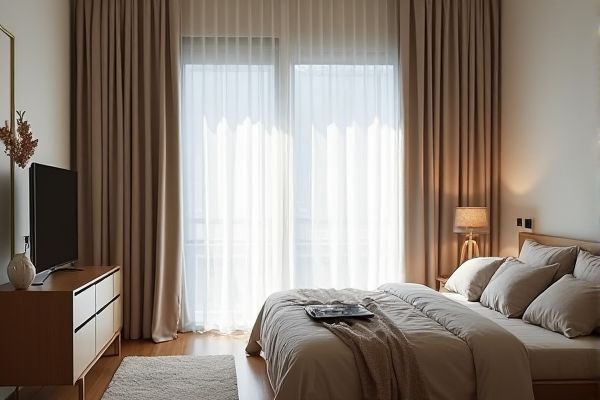
Bed curtains create a cozy, private sleeping space by gently filtering light, while blackout drapes block out nearly all external light for complete darkness and better sleep quality. Explore this article to discover which option suits your bedroom needs and enhances Your rest effectively.
Table of Comparison
| Feature | Bed Curtain | Blackout Drapes |
|---|---|---|
| Primary Purpose | Privacy and partial light blocking around a bed | Complete light blocking for windows |
| Material | Lightweight fabric, often sheer or semi-transparent | Thick, dense fabric designed to block light |
| Light Blocking | Reduces light partially | Blocks up to 99% of light |
| Installation | Mounted around bed frames or ceiling | Mounted on window rods or tracks |
| Noise Reduction | Minimal | Provides some sound insulation |
| Use Case | Bedroom privacy, decorative | Light control, energy efficiency, privacy |
| Cost | Generally lower | Moderate to high |
| Maintenance | Easy to wash and maintain | Requires careful cleaning, often dry clean recommended |
Introduction to Bed Curtains and Blackout Drapes
Bed curtains and blackout drapes serve distinct purposes in enhancing privacy and light control within your bedroom. Bed curtains, often installed around a canopy or bed frame, create a cozy, enclosed space, offering a decorative element and subtle light filtering. Blackout drapes are specifically designed with dense, opaque fabrics to block nearly 100% of external light, making them ideal for improving sleep quality and reducing noise.
Key Differences Between Bed Curtains and Blackout Drapes
Bed curtains primarily serve as privacy screens and decorative elements around beds, typically made from lighter fabrics that allow some light penetration. Blackout drapes are designed with densely woven materials and specialized linings to block nearly 100% of external light, enhancing sleep quality by creating pitch-dark environments. While bed curtains contribute to ambiance and modesty, blackout drapes prioritize functional light control and thermal insulation.
Design and Aesthetic Appeal
Bed curtains create an intimate, cozy ambiance with their soft, flowing fabric options that add a romantic or vintage charm to your bedroom. Blackout drapes offer a sleek, modern aesthetic with clean lines and solid colors or patterns that enhance minimalistic or contemporary decor. Both options provide design versatility, but bed curtains emphasize texture and warmth, while blackout drapes prioritize functionality and bold style.
Light Blocking Capabilities
Bed curtains provide moderate light blocking, creating a cozy and private sleeping environment, but may allow some light to seep through depending on the material. Blackout drapes offer superior light blocking capabilities, effectively eliminating outside light to enhance sleep quality and room darkness. If your priority is maximum darkness for restful sleep, your best option is blackout drapes.
Privacy and Comfort Factors
Bed curtains offer personalized privacy by enclosing the sleeping area, effectively blocking out light and minimizing noise for a cozy, intimate space. Blackout drapes provide strong light blockage and thermal insulation but cover entire windows, offering room-wide privacy rather than individual bed isolation. Choosing between the two depends on whether targeted seclusion around the bed or overall room darkness and comfort is the priority.
Installation and Maintenance
Bed curtains typically install using rods or frames attached to the bed, allowing for easy setup and removal, while blackout drapes require rod installation above windows, which may involve more precise measurements and wall mounting. Maintenance for bed curtains often involves simple washing or spot cleaning due to their smaller size, whereas blackout drapes need regular washing and occasional steaming to maintain their light-blocking properties without damaging the fabric. Your choice depends on whether ease of installation or durability and thorough light blocking better suits your daily routine.
Versatility and Usage Scenarios
Bed curtains offer privacy and create a cozy, enclosed sleeping space suitable for dorm rooms, shared bedrooms, or studio apartments, enhancing both comfort and personal space. Blackout drapes provide superior light-blocking capabilities ideal for bedrooms, media rooms, or home offices where controlling sunlight and reducing glare is critical. Your choice between bed curtains and blackout drapes depends on whether you prioritize versatile spatial separation or optimal light control in various usage scenarios.
Material and Fabric Considerations
Bed curtains often use lightweight, breathable materials like cotton or linen to allow airflow while providing privacy, enhancing comfort in humid environments. Blackout drapes employ dense, tightly woven fabrics such as polyester or triple-weave materials designed to block light completely and enhance insulation. Selecting the right fabric impacts both functionality and ambiance, with bed curtains favoring softness and breathability and blackout drapes prioritizing light blockage and energy efficiency.
Cost Comparison: Bed Curtains vs Blackout Drapes
Bed curtains generally cost less than blackout drapes due to simpler materials and construction, with prices typically ranging from $20 to $50. Blackout drapes, designed with specialized fabrics to block light effectively, often range from $40 to $150 or more depending on size and quality. Choosing bed curtains can be a budget-friendly option for light control, while blackout drapes provide superior light-blocking performance at a higher price point.
Which Option Is Best for Your Space?
Bed curtains provide a cozy, private enclosure ideal for small bedrooms or shared spaces, while blackout drapes excel in blocking light and reducing noise for improved sleep quality. Choosing between bed curtains and blackout drapes depends on your priorities: privacy and aesthetic division versus maximum light control and insulation. For optimal results, consider room size, natural light exposure, and personal sleep needs when selecting the best window treatment or bed enclosure.
 homyna.com
homyna.com